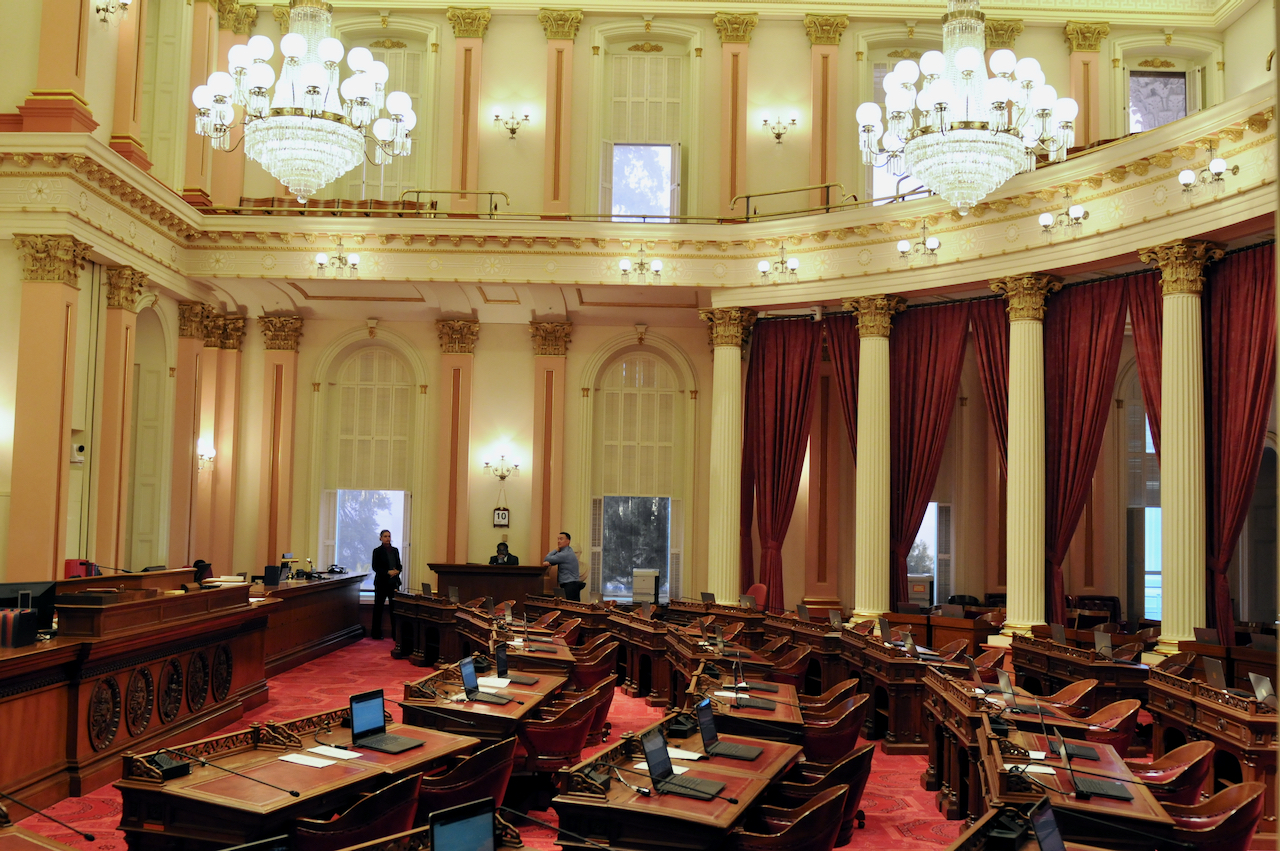
Kids in a classroom. (Photo: Shutterstock/Syda Productions)
Who Is in Charge of Education Policy in California?
Ten of the State Board of Education 11 members are appointed by the Governor
By Chris Micheli, August 13, 2020 6:18 am
There are multiple players who take part in setting education policy in the State of California. Beginning with the California Constitution, Article IX is focused on education. Article 9 was adopted in 1879 as part of the state constitution. This article contains sixteen sections.
Constitutional Provisions
Section 2 provides that a Superintendent of Public Instruction shall be elected by the qualified electors of the State at each gubernatorial election. No Superintendent of Public Instruction may serve more than two terms.
Section 2.1 specifies that the State Board of Education, on nomination of the Superintendent of Public Instruction, shall appoint one Deputy Superintendent of Public Instruction and three Associate Superintendents of Public Instruction who shall be exempt from state civil service and whose terms of office shall be four years.
Section 3 provides that a Superintendent of Schools for each county may be elected by the qualified electors thereof at each gubernatorial election or may be appointed by the county board of education, and the manner of the selection shall be determined by a majority vote of the electors of the county voting.
Section 3.1 states that the Legislature shall prescribe the qualifications required of county superintendents of schools and for these purposes shall classify the several counties in the State.
Section 5 requires that the Legislature provide for a system of common schools by which a free school shall be kept up and supported in each district at least six months in every year, after the first year in which a school has been established.
Section 7 specifies that the Legislature shall provide for the appointment or election of the State Board of Education and a board of education in each county or for the election of a joint county board of education for two or more counties.
Section 7.5 requires the State Board of Education to adopt textbooks for use in grades one through eight throughout the State to be furnished without cost as provided by statute.
Section 8 states that no public money shall ever be appropriated for the support of any sectarian or denominational school, or any school not under the exclusive control of the officers of the public schools; nor shall any sectarian or denominational doctrine be taught, or instruction thereon be permitted, directly or indirectly, in any of the common schools of this State.
Section 9 provides that the University of California shall constitute a public trust, to be administered by the existing corporation known as “The Regents of the University of California,” with full powers of organization and government, subject only to such legislative control as may be necessary to insure the security of its funds and compliance with the terms of the endowments of the university and such competitive bidding procedures as may be made applicable to the university by statute for the letting of construction contracts, sales of real property, and purchasing of materials, goods, and services.
Section 14 provides that the Legislature shall have power, by general law, to provide for the incorporation and organization of school districts, high school districts, and community college districts, of every kind and class, and may classify such districts.
Section 16 allows provisions for the manner in which, the times at which, and the terms for which the members of boards of education shall be elected or appointed, for their qualifications, compensation and removal, and for the number which shall constitute any one of such boards.
Superintendent of Public Instruction
The State Superintendent of Public Instruction (SPI) is the nonpartisan (originally partisan) elected executive officer of the California Department of Education. The SPI directs all functions of the Department of Education, executes policies set by the California State Board of Education, and also chairs the Board.
In addition, he or she serves as the state’s chief spokesperson for public schools, provides education policy and direction to local school districts, and serves as an ex officio member of governing boards of the state’s higher education system.
Department of Education
The California Department of Education (CDE) “serves the state by innovating and collaborating with educators, schools, parents, and community partners.” The CDE is under the direction of the Superintendent of Public Instruction and it implements the policies that have been adopted by the State Board of Education.
State Board of Education
The California State Board of Education (SBE) is the K-12 policy-making body for statewide academic standards, curriculum, instructional materials, assessments, and accountability. It is the role of the SBE to adopt instructional materials for use in grammar schools. The SBE also adopts regulations to implement a wide variety of programs that are enacted by the Legislature, including charter schools and special education.
The State Board of Education, which was established in 1852, is comprised of eleven members. It is found in the state Constitution. By statute, the SBE is the governing and policy-making body of the CDE. The Constitution and statute also assign the SBE a variety of other responsibilities. In addition, the SBE has adopted statewide academic standards for content and student performance in English–language arts, history-social science, mathematics, science, visual and performing arts, and physical education.
Ten of the State Board of Education 11 members are appointed by the Governor to four-year, staggered terms that are subject to confirmation by a two-thirds vote of the Senate within one year of appointment. The eleventh member, also appointed by the Governor and subject to Senate confirmation, is a California public high school student who serves a one-year term. The student member enjoys full voting rights and all other rights and privileges of SBE membership.
Among the key roles of the SBE are to adopt curriculum frameworks, instructional materials. In addition, the State Board of Education considers requests from local educational agencies to waive statutory and regulatory requirements. The SBE adopts tests and sets policies for the statewide assessment system.
Moreover, the State Board of Education reviews and acts on petitions to unify and reorganize school districts by determining whether the petitions meet statutorily established criteria. All-charter district petitions are submitted directly to the SBE and the State Superintendent of Public Instruction, who have joint approval authority.
As prescribed by state and federal law, the State Board of Education approves allocation of certain state and federal funding sources. The SBE is authorized to study the educational conditions and needs of the state and plan improvement of the administration and efficiency of public schools. When authorized by statute, the SBE approves certain program plans for CDE.
- Control of California Harbors - December 10, 2025
- Joint Custody under California Law - December 9, 2025
- Change of Name in California - December 9, 2025





Thank you for this thorough overview article. I would point out one small oversight. The SBE has also adopted academic standards in Health as well as Computer Science; two fields often overlooked but more and more crucial to young people’s future trajectories.
Have a nice day!
The actual control is the radical gay/lesbian/transgender mafia.
That’s correct, I was trying to look that person up but I can’t find that him- I thing he’s a trans. male/female. I first heard of him and saw him on the news when President Trump removed him and assigned, I think a decent lady and then when biden was sworn in he immediately started signing policies that President Trump removed, back into policy and I remember seeing on the news that that gay/lesbian guy was one of them, and so he put him back as head of/chief head of America’s education……..insane perv!
I’d say it’s the teachers union that is in control, if it’s in control at all?
Hi!
I need to come in touch with authors of the standards of social sciences k-12. Could you please advise?
Thanks